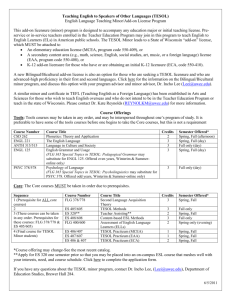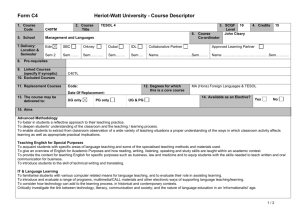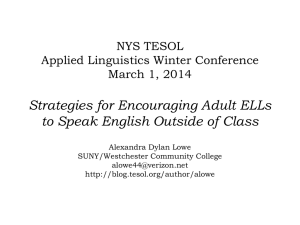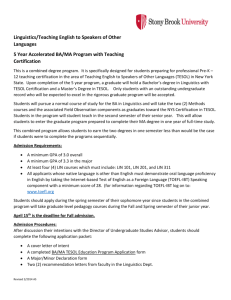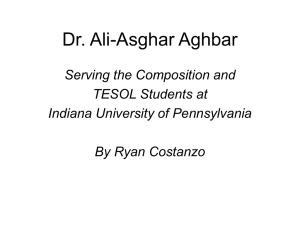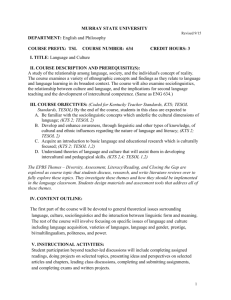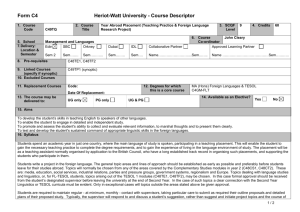MA TESOL with Applied Linguistics - University of Central Lancashire
advertisement
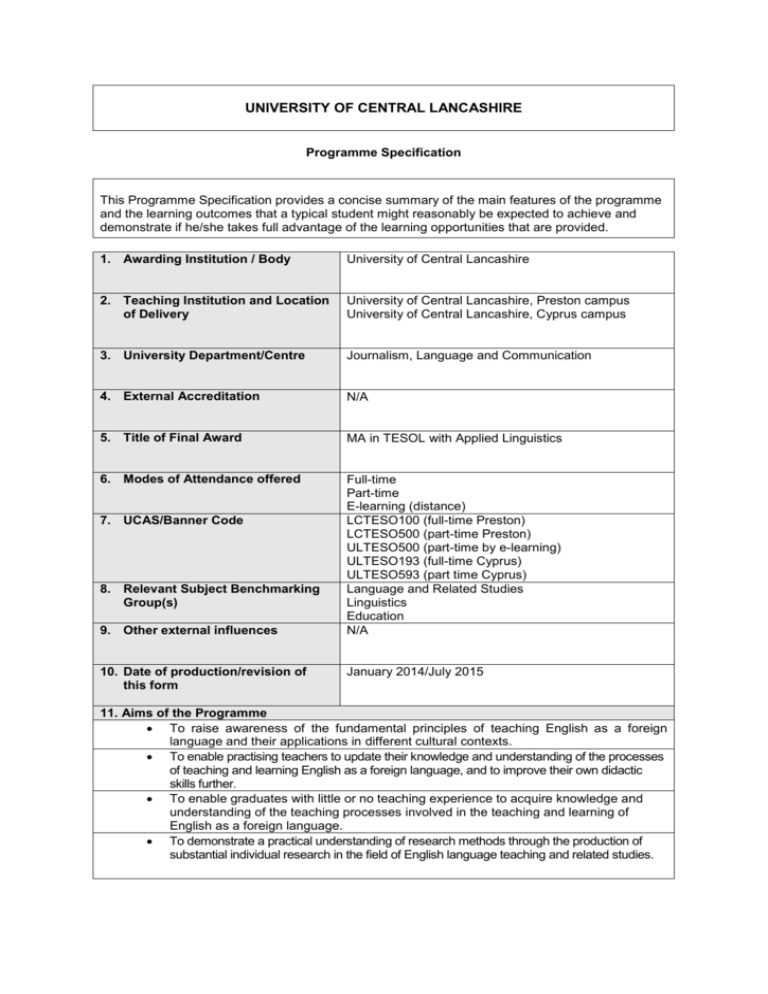
UNIVERSITY OF CENTRAL LANCASHIRE Programme Specification This Programme Specification provides a concise summary of the main features of the programme and the learning outcomes that a typical student might reasonably be expected to achieve and demonstrate if he/she takes full advantage of the learning opportunities that are provided. 1. Awarding Institution / Body University of Central Lancashire 2. Teaching Institution and Location of Delivery University of Central Lancashire, Preston campus University of Central Lancashire, Cyprus campus 3. University Department/Centre Journalism, Language and Communication 4. External Accreditation N/A 5. Title of Final Award MA in TESOL with Applied Linguistics 6. Modes of Attendance offered Full-time Part-time E-learning (distance) LCTESO100 (full-time Preston) LCTESO500 (part-time Preston) ULTESO500 (part-time by e-learning) ULTESO193 (full-time Cyprus) ULTESO593 (part time Cyprus) Language and Related Studies Linguistics Education N/A 7. UCAS/Banner Code 8. Relevant Subject Benchmarking Group(s) 9. Other external influences 10. Date of production/revision of this form January 2014/July 2015 11. Aims of the Programme To raise awareness of the fundamental principles of teaching English as a foreign language and their applications in different cultural contexts. To enable practising teachers to update their knowledge and understanding of the processes of teaching and learning English as a foreign language, and to improve their own didactic skills further. To enable graduates with little or no teaching experience to acquire knowledge and understanding of the teaching processes involved in the teaching and learning of English as a foreign language. To demonstrate a practical understanding of research methods through the production of substantial individual research in the field of English language teaching and related studies. To develop a critical understanding of key areas of relevance in Applied Linguistics and their practical application within TESOL.. 12. Learning Outcomes, Teaching, Learning and Assessment Methods A. Knowledge and Understanding A1. Knowledge of applied linguistic theories and fundamental principles related to teaching English as a foreign language. A2. Awareness of the roles of teachers and learners in the EFL classroom. A3. Demonstration of ability to construct syllabuses, lesson plans and design teaching materials for learners of EFL. A4. Comprehension of processes and skills necessary for undertaking independent research A5. Plan, prepare and deliver coherent lessons in ESOL drawing on TESOL principles and methods and responding to the particular needs of learners. Teaching and Learning Methods Lectures and Workshops (Learning outcomes A1, 2, 4 and 5) Analysis of case studies (Learning outcomes A1, 2, 4 and 5) Pairwork and groupwork (Learning outcome A2, 3 and 4) Teaching practicum (A2, 3 and 5) Course Management System (Blackboard) acts as a central gateway for teaching materials and guided and independent learning activities (A1, 2, 3, 4 and 5). Web-based recorded video and/or audio lectures and workshops (Learning outcomes A1, 2, 4 and 5). Analysis of case studies (Learning outcomes A1, 2, 3, 4 and 5). Web-based video conferencing (A1, 2, 3, 4 and 5). Web-based asynchronous discussion forums (A1, 2, 3, 4 and 5). Assessment methods Teaching practicum (Learning outcomes A2, 3 and 5) Reflective journal (Learning outcomes A2, 3 and 5) Simulations (Learning outcomes A1, 2 and 3) Presentations (Learning outcomes A1, 2 and 3) Academic Essay (Learning outcomes A1, 2 and 3) Exam (Learning outcome A1) Discussion forums (Learning outcome A1, 2, 3 and 4). B. Subject-specific skills B1. Examine some of the major principles of discourse analysis, corpus linguistics, semantics and pragmatics in order to explore the relationship between linguistic forms and the users of those forms. B2. Demonstrate and put into practice contemporary TESOL approaches, methodologies, classroom management skills, language awareness and analysis in a manner appropriate to lesson aims and to the learners’ background and needs. B3. Describe, critically appraise and reflect on current teaching methodologies; B4. Analyse the applications of SLA theories to current language teaching methods, approaches and materials development. B5. Analyse and organise systematically data for research. Teaching and Learning Methods Lectures and Workshops (Learning outcomes B1, 2, 3, 4 and 5) Analysis of case studies (Learning outcomes B1, 2, 3 and 4) Pairwork and groupwork (Learning outcome B1, 2, 3, 4 and 5) Teaching practicum (Learning outcomes B2 and 3) Course Management System (Blackboard) acts as a central gateway for teaching materials and guided and independent learning activities (B1, 2, 3, 4 and 5). Web-based recorded video and/or audio lectures and workshops (Learning outcomes B1, 2, 4 and 5). Analysis of case studies (Learning outcomes B1, 2, 4 and 5). Web-based video conferencing (B1, 2, 3, 4 and 5). Web-based asynchronous discussion forums (B1, 2, 3, 4 and 5). Assessment methods Teaching practicum (Learning outcomes B2 and 3) Reflective journal (Learning outcomes B2 and 3) Simulations (Learning outcomes B2, 3 and 4) Presentations (Learning outcomes B1, 2, 3 and 4) Academic Essay (Learning outcomes B1, 2, 3, 4 and 5) Exam (Learning outcome B1) Portfolio (Learning outcome B1) Dissertation (Learning outcome B1, 2, 3, 4 and 5) Discussion forums (Learning outcome A1, 2, 3 and 4). C. Thinking Skills C1. Identify relevant principles and theories underpinning the teaching of English as a foreign language for professional purposes. C2. Analyse linguistic and social processes involved in language acquisition. C3. Demonstrate skill and awareness of various factors in classroom management and in the teaching and learning of English as a foreign language. C4. Critically evaluate the relevance and effectiveness of various types of language teaching materials for the EFL classroom. C5. Identify and investigate a pedagogical area of study in TESOL through the collection, synthesis and evaluation of data from a variety of sources so as to establish relationships in the data findings. Teaching and Learning Methods Lectures and Workshops (Learning outcomes C1, 2, 3, 4 and 5) Analysis of case studies (Learning outcomes C1, 2, 3 and 4) Pairwork and groupwork (Learning outcome C1, 2, 3, 4 and 5) Teaching practicum (Learning outcomes C1, 3 and 4) Assessment methods Teaching practicum (Learning outcomes C1, 3 and 4) Reflective journal (Learning outcomes C1, 3, 4 and 5) Simulations (Learning outcomes C2 and 3) Presentations (Learning outcomes C1, 2, 3 and 4) Academic Essay (Learning outcomes C1, 2, 3, 4 and 5) Exam (Learning outcome C1, 2, 3 and 5) Portfolio (Learning outcome C1, 2, 3 and 4) Dissertation (Learning outcome C1, 2, 3, 4 and 5) D. Other skills relevant to employability and personal development D1. Manage information in order to evaluate their relevance for specific areas of investigation D2. Ability to work autonomously, or with minimal guidance where appropriate D3. Problem-solving in relation to the selection of appropriate techniques and materials to suit different interactional contexts. D4. Initiate and lead debate as appropriate D5. Reflective practice as part of personal development planning D6. Self-discipline, motivation and flexibility Teaching and Learning Methods Lectures and Workshops (Learning outcomes D1, 2, 3, 4, 5 and 6) Analysis of case studies (Learning outcomes D1 and 4) Pairwork and groupwork (Learning outcome D1, 2, 3, 4, 5 and 6) Teaching practicum (Learning outcomes D2, 3, 5 and 6) Assessment methods Teaching practicum (Learning outcomes D2, 3, 5 and 6) Reflective journal (Learning outcomes D1, 2, 3, 4, 5 and 6) Simulations (Learning outcomes D1, 2, 3 and 4) Presentations (Learning outcomes D1, 2, 3, 4 and 6) Academic Essay (Learning outcomes D1, 2, 3, 4, 5 and 6) Exam (Learning outcome D1, 2 and 3) Portfolio (Learning outcome D1, 2, 3, 4, 5 and 6) Dissertation (Learning outcome D1, 2, 3, 4, 5 and 6) 13. Programme Structures* Level Module Code Module Title 14. Awards and Credits* Credit rating UK/ECTS Compulsory Modules Level 7 EB4501 EB4502 EB4503 EB4505 EB4504 EB4511 EB4514 EB4512 EB4515 EB4510 EB4507 EB4509 EB4650 Language Analysis Methodology in TESOL Second Language Acquisition Dissertation Optional Modules Course and Materials Design Student-Initiated Module (SIM) in TESOL/Applied Linguistics Language in Interaction Corpus-Informed Language Teaching Computer-Assisted Language Learning Teaching English for Academic and Specific Purposes Testing and Assessment Teaching Business English The analysis of language and practice for the TESOL classroom World Englishes EB4719 20 / 10 20 / 10 20 / 10 20 / 10 20 / 10 20 / 10 20 / 10 20 / 10 20 / 10 20 / 10 EB4516 EB4570 EB4720 20 / 10 20 / 10 20 / 10 60 / 30 TESOL Work Placement Teaching Language through Literature Teaching English to Young Learner 20 / 10 20 / 10 20 / 10 Option Module for Cyprus Only EH4107 Curriculum Design 20 / 10 Compulsory modules Language Analysis Second Language Acquisition Methodology in TESOL Dissertation 20 / 10 20 / 10 20 / 10 60 / 30 Elearning EB4710 EB4711 EB4712 EB4718 Optional Modules EB4713 EB4714 Course and Materials Design Testing and Assessment in TESOL 20 / 10 20 / 10 EB4715 Student-Initiated Module (SIM) in TESOL/Applied Linguistics Language in Interaction Teaching English for Academic and Specific Purposes 20 / 10 Corpus Informed Language Teaching Computer-Assisted Language Learning 20 / 10 EB4716 EF4701 EF4702 EF4703 20 / 10 20 / 10 20 / 10 Masters Degree in TESOL with Applied Linguistics Requires 180 credits at Level 6 or above with a minimum of 160 credits at Level 7. PG Diploma in TESOL with Applied Linguistics Requires 120 credits, of which 100 credits must be taken at Level 7. PG Certificate in TESOL with Applied Linguistics requires 60 credits in total, of which 40 credits must be taken at Level 7. Optional Modules Level 6 EB3602 Teaching Practicum 20 / 10 15. Personal Development Planning PDP will be used in many different ways to support the development of academic and general skills in this programme. PDP processes to be developed are: Planning Performance Data gathering Critical reviewing Evaluating The above PDP processes will be made explicit through the following modes of assessment and progress can be reviewed through: Teaching practicum Dissertations Written essays Independent project-work Group projects Simulations Reflective journals Portfolios In addition, students will have ample opportunity to build on the above areas and to reflect on their individual action plans (e.g. employability prospects and transferable skills) via the Personal Tutoring system in the Department of Languages and International Studies. The management of this system is documented in the attached Personal Tutoring Manual (Guidelines for Staff). 16. Admissions criteria Programme Specifications include minimum entry requirements, including academic qualifications, together with appropriate experience and skills required for entry to study. These criteria may be expressed as a range rather than a specific grade. Amendments to entry requirements may have been made after these documents were published and you should consult the University’s website for the most up to date information. Students will be informed of their personal minimum entry criteria in their offer letter. The criteria for delivery on campus (Preston) and by e-learning are as follows: A minimum of a lower second-class honors degree is usually required. Applicants should be able to demonstrate appropriate teaching experience in language education (typically at least 1-2 years) and/or a pre-service certificate (Cambridge CELTA/Trinity Cert. TESOL or equivalent). Non-native English speakers will require an English level of IELTS 6.5 (or equivalent), with a minimum of 6.0 in all sub-scores. The criteria for delivery on Cyprus campus are as follows: A minimum of a lower second-class honors degree is usually required. Teaching experience is not essential for face to face delivery but preferred. Tutoring experience is helpful. Non-native English speakers will require an English level of IELTS 6.5 (or equivalent), with a minimum of 6.0 in all subscores. 17. Key sources of information about the programme UCAS handbook Fact Sheet Website; www.uclan.ac.uk Phone number: +44 (0)1772 893158 18. Curriculum Skills Map Please tick in the relevant boxes where individual Programme Learning Outcomes are being assessed Programme Learning Outcomes Core (C), Compulsory Module (COMP) or Knowledge and Subject-specific Level Code Module Title Option (O) understanding Skills Thinking Skills LEVEL 7 A1 EB4501 Language Analysis EB4502 Methodology in TESOL EB4503 Second Language Acquisition EB4504 Course and Materials Design EB4505 Dissertation EB4511 Student-Initiated Module (SIM) in TESOL/Applied Linguistics EB 4004 Second Language Writing EB 4514 Language in Interaction EB 4512 Corpus-Informed Language Teaching EB 4515 Computer-Assisted Language Learning EB 4510 Teaching English for Academic and Specific Purposes EB 4507 Testing and Assessment EB 4509 Teaching Business English COMP CORE CORE √ O √ EB 4650 The analysis of language and practice for the TESOL classroom EB 4516 World Englishes EB 4570 TESOL Work Placement √ CORE O A2 A3 A4 √ B1 A5 √ B2 √ √ √ √ √ √ √ √ B3 √ √ √ B4 √ B5 C1 √ C2 √ √ √ √ √ √ √ √ C3 √ √ D1 √ √ √ √ √ √ √ √ √ √ √ √ √ √ √ √ √ √ √ √ √ √ D3 √ √ D4 √ √ √ √ √ √ √ √ √ √ √ √ √ √ √ √ √ √ √ √ O √ √ √ √ √ √ O √ √ √ √ √ √ √ √ √ √ O O √ √ √ √ √ √ √ √ √ √ O √ √ √ √ √ √ √ √ √ √ √ √ √ O O √ √ √ √ √ √ √ √ √ √ √ √ √ √ √ √ √ √ √ √ √ √ √ √ √ √ √ √ √ √ √ √ √ √ √ √ √ √ √ √ √ √ √ √ √ √ √ √ √ √ √ √ √ √ √ √ √ √ √ √ √ √ D6 √ √ √ √ D5 √ O O O √ √ D2 √ √ √ √ √ C5 √ √ √ √ C4 Other skills relevant to employability and personal development √ √ √ √ √ L6 EB4720 Teaching Language through Literature EB4719 Teaching English to Young Learners EB3602 Teaching Practicum LEVEL 7 EH4107* Curriculum Design Elearning EB4710 Language Analysis EB4712 Methodology in TESOL Second Language EB4711 Acquisition EB4718 Dissertation Course and Materials EB4713 Design Student-Initiated Module (SIM) in TESOL/Applied EB4715 Linguistics Testing and Assessment in EB4714 TESOL EB4717 Second Language Writing Teaching English for Academic and Specific EF4701 Purposes Corpus Informed Language EF4702 Teaching Computer-Assisted EF4703 Language Learning EB4716 Language in Interaction *Option module for Cyprus only O √ √ √ √ √ √ √ √ √ √ √ √ √ √ √ √ √ √ √ √ √ √ √ √ √ √ √ √ √ √ √ √ √ √ √ √ √ √ √ O A1 COMP CORE √ √ √ √ √ A2 A3 A4 √ √ A5 √ √ B1 √ √ √ CORE CORE √ √ √ √ √ √ √ √ √ √ B2 B3 B4 B5 C1 √ √ √ √ √ √ √ √ √ √ √ √ √ √ √ √ √ √ C2 √ √ √ √ √ √ √ √ √ √ C3 C4 C5 D1 D2 D3 D4 D5 D6 √ √ √ √ √ √ √ √ √ √ √ √ √ √ √ √ √ √ √ √ √ √ √ √ √ √ √ √ √ √ √ √ √ √ √ √ √ √ O √ √ √ √ √ √ √ √ √ √ √ √ √ O √ O O √ √ √ √ √ √ √ √ √ √ √ √ √ √ √ √ √ √ √ √ √ √ √ √ √ √ √ √ √ √ √ √ √ √ O √ √ √ √ √ √ √ √ √ √ √ √ √ √ O O O √ √ √ √ √ √ √ √ √ √ √ √ √ √ √ √ √ √ √ √ √ √ √ √ √ √


